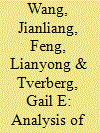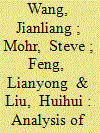|
|
|
Sort Order |
|
|
|
Items / Page
|
|
|
|
|
|
|
| Srl | Item |
| 1 |
ID:
121389


|
|
|
|
|
| Publication |
2013.
|
| Summary/Abstract |
Many people believe that China's economic growth can continue almost indefinitely. For a manufacturing-based economy such as China's to continue to grow, it needs an adequate supply of inexpensive energy. To date, this energy growth has primarily come from coal, but China's indigenous coal supplies are now falling short of the amount needed to support this growth. In this situation, the status of China's future coal supply will be very important for China's future economic development. Our analysis shows that China's ultimate recoverable coal reserves equal 223.6×109 MT, and its production will peak between 2025 and 2030, with peak production of approximately 3.9×109 MT. The extent to which China can import coal in the future is uncertain. With rising coal demand, this combination is likely to create a significant challenge to China's future economic development.
|
|
|
|
|
|
|
|
|
|
|
|
|
|
|
|
| 2 |
ID:
150353


|
|
|
|
|
| Summary/Abstract |
China is vigorously promoting the development of its unconventional gas resources because natural gas is viewed as a lower-carbon energy source and because China has relatively little conventional natural gas supply. In this paper, we first evaluate how much unconventional gas might be available based on an analysis of technically recoverable resources for three types of unconventional gas resources: shale gas, coalbed methane and tight gas. We then develop three alternative scenarios of how this extraction might proceed, using the Geologic Resources Supply Demand Model. Based on our analysis, the medium scenario, which we would consider to be our best estimate, shows a resource peak of 176.1 billion cubic meters (bcm) in 2068. Depending on economic conditions and advance in extraction techniques, production could vary greatly from this. If economic conditions are adverse, unconventional natural gas production could perhaps be as low as 70.1 bcm, peaking in 2021. Under the extremely optimistic assumption that all of the resources that appear to be technologically available can actually be recovered, unconventional production could amount to as much as 469.7 bcm, with peak production in 2069. Even if this high scenario is achieved, China’s total gas production will only be sufficient to meet China’s lowest demand forecast. If production instead matches our best estimate, significant amounts of natural gas imports are likely to be needed.
|
|
|
|
|
|
|
|
|
|
|
|
|
|
|
|
| 3 |
ID:
119846


|
|
|
|
|
| Publication |
2013.
|
| Summary/Abstract |
In order to achieve energy consumption targets, and subsequently reduce carbon emissions, China is working on energy strategies and policies aimed at actively increasing the consumption of natural gas-the lowest carbon energy of the fossil fuels, and to enhance the proportion of gas in total primary energy consumption. To do this, it is a necessary prerequisite that China must have access to adequate gas resources and production to meet demand. This paper shows that the availability of domestic gas resources are overestimated by China's authorities due to differences in classification and definitions of gas resources/reserves between China and those accepted internationally. Based on official gas resource figures, China's gas production remains low with respect to the projected demand, and will only be 164.6 bcm in 2020, far lower than the 375 bcm of forecast demand. The gap between gas production and demand will reach 210.4 bcm by 2020. Existing plans for the importation of gas and the development of unconventional gas will not close this gap in the next 10 years, and this situation will therefore present a severe challenge to China's gas security, achievement of targets in improving energy consumption structure and reducing carbon emissions.
|
|
|
|
|
|
|
|
|
|
|
|
|
|
|
|
| 4 |
ID:
110704


|
|
|
|
|
| Publication |
2011.
|
| Summary/Abstract |
This paper introduces two typical multicyclic models: the Hubbert model and the Generalized Weng model. The model-solving process of the two is expounded, and it provides the basis for an empirical analysis of the world's conventional oil production. The results for both show that the world's conventional oil (crude+NGLs) production will reach its peak in 2011 with a production of 30 billion barrels (Gb). In addition, the forecasting effects of these two models, given the same URR are compared, and the intrinsic characteristics of these two models are analyzed. This demonstrates that for specific criteria the multicyclic Generalized Weng model is an improvement on the multicyclic Hubbert model. Finally, based upon the resultant forecast for the world's conventional oil, some suggestions are proposed for China's policy makers.
|
|
|
|
|
|
|
|
|
|
|
|
|
|
|
|
|
|
|
|
|